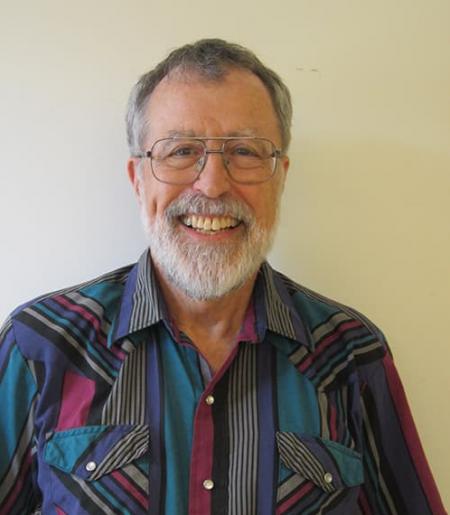Overview
Dr. Bradbury received his BA in Biology from Reed College (Portland, OR) in 1963. He completed his PhD with advisor Dr. Donald Griffin in Animal Behavior at Rockefeller University (New York, NY) in 1968, and then spent two years in Trinidad on a postdoctoral fellowship studying tropical bat social behavior. He has served on the biology faculties of Rockefeller University, the University of California, San Diego, and Cornell University. He is a Fellow of the Animal Behavior Society and a past President of the International Society for Behavioral Ecology.
Research Focus
Dr. Bradbury’s research efforts have included field studies on mating system evolution and social dispersion in tropical bats, the evolution of leks in African fruit bats and grouse, foraging dispersions of African antelopes, sexual selection in hermaphroditic sea slugs, and most recently, the functions of vocal mimicry in wild parrots. Dr. Bradbury retired in July 2009, and is no longer supervising students.
Publications
- Bradbury, J.W. and T. J. S. Balsby. 2016. The functions of vocal learning in parrots. Behavioral Ecology and Sociobiology 70: 293-312.
- Bradbury, J.W., S.L. Vehrencamp, and K. E. Clifton. 2015. The ideal free antelope: foraging dispersions. Behavioral Ecology 26:1303-1313.
- Bradbury, J.W. and S. L. Vehrencamp. 2014. Choice of regression model for isodar analysis. Evolutionary Ecology Research 16: 689-704.
- Bradbury, J.W. and S.L. Vehrencamp. 2014. Complexity and behavioral ecology. Behavioral Ecology 25: 435-442.
- Berg, K.S., S. Delgado, R. Okawa, S.R. Beissinger, and J.W. Bradbury. (2011). Contact calls are used for individual mate recognition in free-ranging green-rumped parrotlets, Forpus passerinus. Animal Behaviour 81:241-248.
- Bradbury, J.W. and S.L. Vehrencamp. 2011. Principles of Animal Communication, 2nd Edition. Sinauer Associates, Sunderland MA.
- Buhrman-Deever, S.C., A.R. Rappaport, and J.W. Bradbury. (2007). Geographic variation in contact calls of feral US populations of the monk parakeet. The Condor 109:389-398.
- Patricelli GL, M. Dantzker, and J.W. Bradbury, (2007). Differences in acoustic directionality among vocalizations of the male red-winged blackbird (Agelaius phoeniceus) are related to function in communication. Behavioral Ecology and Sociobiology 61:1099-1110.
- Cortopassi, K.A. and J.W. Bradbury. (2006). Contact call diversity in wild orange-fronted parakeet pairs, Aratinga canicularis. Anim. Behav. 71: 1141-1154.
- Bradbury, J.W. and T. Balsby. (2006). The mystery of mimicry. PsittaScene 18(3):8-11.
- Dantzer, M.S. and J.W. Bradbury. (2006). Vocal sacs and their role in avian acoustic display. Acta Zoologica Sinica 52 (Supplement):486-488.
- Bradbury, J.W. (2003). Vocal communication in wild parrots. In: Animal Social Complexity: Intelligence, Culture and Individualized Societies. F.B.M. DeWaal and P. L. Tyack, eds. Harvard University Press, Cambridge MA, pp. 293-316.
- Wright, T.F., K.A. Cortopassi, J.W. Bradbury, and R.J. Dooling. (2003). Hearing and vocalizations in the conure Aratinga canicularis. J. Comp. Psychol. 117:87-95.
- Vehrencamp, S.L., A. Ritter, M. Keever, and J. W. Bradbury. (2003). Responses to playback of local versus distant contact calls in the Orange-Fronted Conure (Aratinga canicularis). Ethology 109:37-54.
- Angeloni, L., J.W. Bradbury, and R.S. Burton. (2003). Multiple mating, paternity, and body size in a simultaneous hermaphrodite, Aplysia californica. Behavioral Ecology 14: 554-560.
- Angeloni, L., J.W. Bradbury, and E.L. Charnov (2002). Body size and sex allocation in simultaneously hermaphroditic animals. Behavioral Ecology 13:419-426.
- Bradbury, J. W., K. A. Cortopassi, and J. R. Clemmons. (2001). Geographical variation in the contact calls of Orange-fronted Conures. The Auk 118:958-972.
- Bradbury, J.W. and S.L. Vehrencamp (2000). Economic models of animal communication. Anim. Behav. 59:259-268.
- Cortopassi, K.A. and J.W. Bradbury. (2000). The comparison of harmonically rich sounds using spectrographic cross-correlation and principal coordinates analysis. Bioacoustics 11:89-127.

